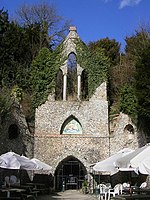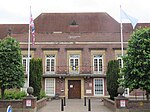West Wycombe

West Wycombe is a small village famed for its manor houses and its hills. It is three miles west of High Wycombe, Buckinghamshire, England. The historic village is largely a National Trust property and receives a large annual influx of tourists – being the site of West Wycombe Park, West Wycombe Caves and the Mausoleum on top of West Wycombe Hill. The Mausoleum and Golden Ball above West Wycombe village are impressive local landmarks, visually dominating the village and local landscape for miles surrounding. West Wycombe Park, Caves, Mausoleum and St Lawrence's Church were all constructed in the mid-18th century by Sir Francis Dashwood, founder of the Dilettanti Society and co-founder of the notorious Hellfire Club.
Excerpt from the Wikipedia article West Wycombe (License: CC BY-SA 3.0, Authors, Images).West Wycombe
Kitty's Walk,
Geographical coordinates (GPS) Address Nearby Places Show on map
Geographical coordinates (GPS)
| Latitude | Longitude |
|---|---|
| N 51.643143 ° | E -0.799635 ° |
Address
Temple of Music
Kitty's Walk
HP14 3AB , West Wycombe
England, United Kingdom
Open on Google Maps









